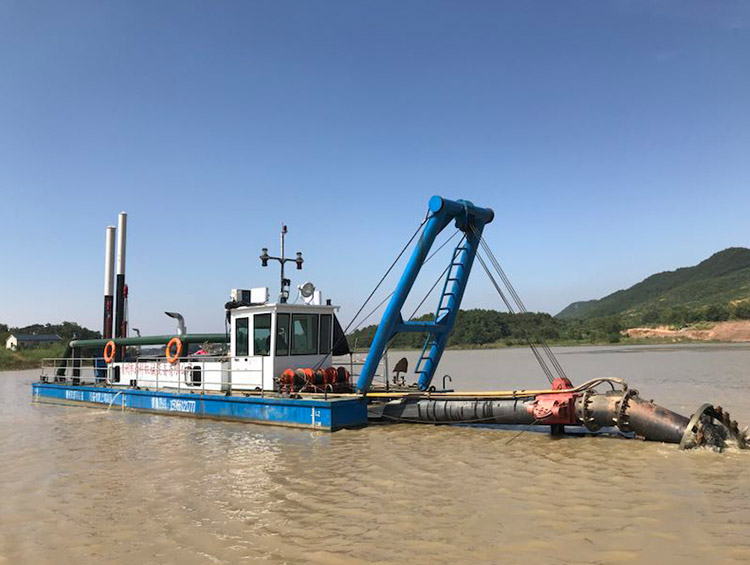 English
English Español
Español  Português
Português  русский
русский  Français
Français  日本語
日本語  Deutsch
Deutsch  tiếng Việt
tiếng Việt  Italiano
Italiano  Nederlands
Nederlands  ภาษาไทย
ภาษาไทย  Polski
Polski  한국어
한국어  Svenska
Svenska  magyar
magyar  Malay
Malay  বাংলা ভাষার
বাংলা ভাষার  Dansk
Dansk  Suomi
Suomi  हिन्दी
हिन्दी  Pilipino
Pilipino  Türkçe
Türkçe  Gaeilge
Gaeilge  العربية
العربية  Indonesia
Indonesia  Norsk
Norsk  تمل
تمل  český
český  ελληνικά
ελληνικά  український
український  Javanese
Javanese  فارسی
فارسی  தமிழ்
தமிழ்  తెలుగు
తెలుగు  नेपाली
नेपाली  Burmese
Burmese  български
български  ລາວ
ລາວ  Latine
Latine  Қазақша
Қазақша  Euskal
Euskal  Azərbaycan
Azərbaycan  Slovenský jazyk
Slovenský jazyk  Македонски
Македонски  Lietuvos
Lietuvos  Eesti Keel
Eesti Keel  Română
Română  Slovenski
Slovenski  मराठी
मराठी  Srpski језик
Srpski језик
What is the dredging process?
2022-08-04
The dredging process includes major links or stages such as underwater sediment excavation, vertical lifting of dredged sediment, horizontal transportation and disposal of sediment, and construction operations at different stages will have different impacts on the environment.
Underwater Sediment Excavation
The main purpose of this step is to remove the sediment to be dredged from the original position, and use tools such as buckets, buckets, Dredger Cutter, and rakes to excavate. Under the extrusion and cutting action of the above devices, the cohesion of the bed surface sediment is reduced Damaged and displaced, part of the sediment was transported by dredging equipment to other places for further treatment, part of the sediment was scattered near the dredging point, and part of the sediment was suspended in the water body.In the process of excavating sediment, the impact on the environment includes:
(1) Increase the concentration of suspended sediment, and part of the sediment enters a suspended state under the action of the rotary cutting of the dredging equipment. Type of equipment, excavation energy, vertical lift method and other construction parameters;
(2) Release of pollutants. The polluted sediment suspended in the water body will release pollutants into the water body through desorption. The release intensity and rate are affected by the concentration of suspended sediment, the background adsorption value of the sediment, the physical and chemical environment of the water body, and the adsorption power.
(3) If the dredging residual sediment contains pollutants, it will become a new pollution source.
Dredging Sediment Vertical LiftThe second critical part of the dredging process is to lift the excavated sediment to the surface, either mechanically or hydraulically, depending on the dredging vessel used. When a mechanical dredger is used, the dredged sediment is placed in a mud bucket and lifted to the water surface. When a hydraulic dredger is used, a suction pipe is usually used to absorb the dredged sediment. Under the action of a centrifugal pump, the muddy water The mixture is sucked into the suction pipe and transported to the destination through the sludge discharge line.The impact of the excavated sediment on the environment during the lifting process includes:
(1) If an open dredger is used for mechanical transportation, it will inevitably come into contact with the water body during the lifting process. The concentration of suspended sediment will increase, and the concentration of suspended sediment is affected by factors such as the type and capacity of the dredger, and the lifting speed;
(2) When using hydraulic conveying, the main influencing factor is the suction capacity of the suction pipe. If the suction capacity is not enough to transport all the excavated sediment, a large amount of dredging residues will be generated to pollute the environment;
(3) If a trailing suction dredger or a mud barge is used to load the mud-water mixture, the overflow will increase the concentration of suspended sediment and pollutants in the water body.

Horizontal Conveying Of Dredged Sediment
The sediment excavated from the bed surface and lifted to the water surface needs to be transported to the destination for further disposal or treatment. The horizontal transportation methods include trailing suction dredger transportation, mud barge transportation and hydraulic pipeline transportation,Generally speaking, mechanical dredging is transported by barge, hydraulic dredger is transported by pipeline, and trailing suction dredger can be transported directly by ship.Compared with other stages, the impact of the horizontal transportation of dredged sediment on the environment is relatively small, and the main risk comes from the leakage of dredged sediment.
Dredging And Sediment Disposal
After the dredged sediment is transported to the destination, it is further disposed of according to the purpose of dredging, the characteristics of the sediment and the degree of availability, including land reclamation, shore beach maintenance, marine disposal, land disposal, isolation disposal, etc. The disposal of dredged sediment is the final stage of the dredging project. Different disposal locations have different impacts on the environment:(1) If underwater disposal is adopted, under the action of hydrodynamics, fine-grained sediment will spread and move around to varying degrees;(2) If land disposal is adopted, such as land reclamation and shore beach maintenance, the main pollution mainly comes from residual water discharge and overflow in the process of mud-water separation;(3) In addition, if the corresponding protection measures are not taken, the onshore treatment of dredged sediment may also have a negative impact on the groundwater quality near the disposal site.



